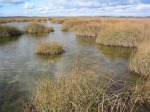Swamps and marshes are easily interchanged as they are both areas of vegetation that are susceptible to flooding. In North America they are defined a little differently (check out this BCS post for a quick lesson in wetland ecology – image below). A swamp is a place where the plants that make up the area covered in water are primarily woody plants or trees. Woody plants would be mangroves or cypress trees. A marsh, on the other hand, is defined as having no woody plants. The non-woody plants would be saltmarsh grasses, reeds, or sedges. Also, marshes are typically not as deep as swamps.
Both swamps and marshes are great place for wildlife. With so many plants in the water, fish use marshes and swamps as a nursery ground. The plants are a great place to hide their eggs and are a hiding spots for juvenile fish to hide from predators.
Swamps and marshes can be either freshwater, saltwater, or a mixture of both. Some marshes or swamps are found in bodies of water that are a mixture of freshwater and saltwater, known as an estuary.
Image (c) top – en.tourduvalat.org; bottom – www.tpwd.state.tx.us
Do you have a question that needs to be answered? Just e-mail us at info@beachchairscientist.com.











What people are saying …